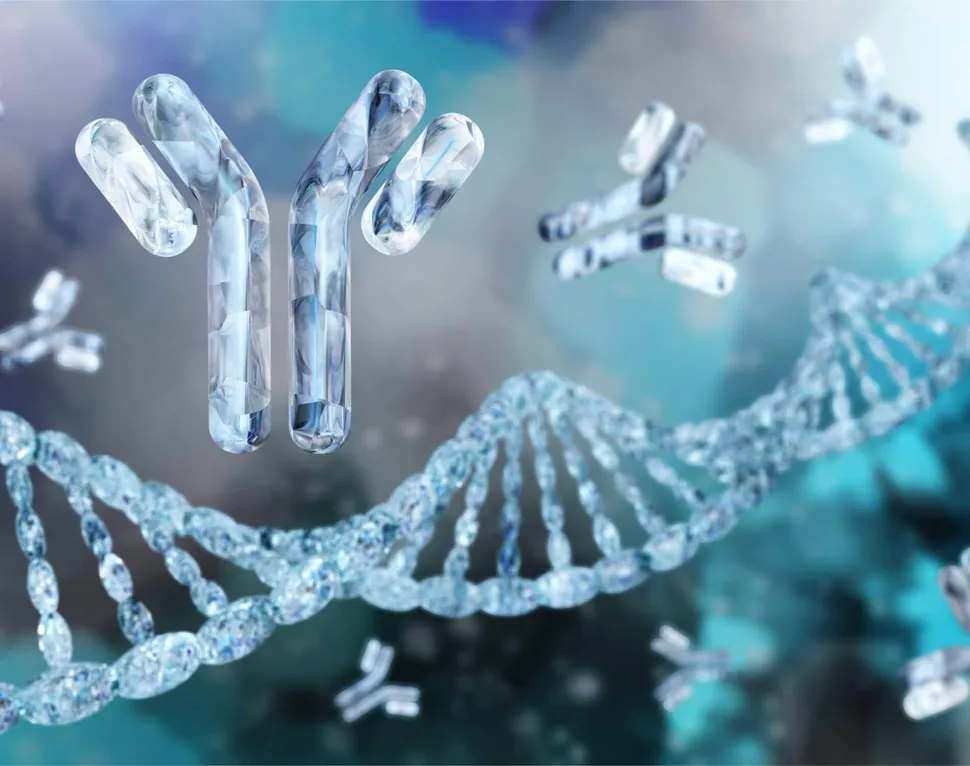Antibody Drug Conjugates As Immunotherapy In Myeloma

Antibody Drug Conjugates (ADCs) are a new type of immunotherapy that is being developed and tested in multiple myeloma. To better understand how and why ADCs work, we first need to look at some different classifications of drugs that have traditionally been used to treat multiple myeloma.
Chemotherapy
Chemotherapy has been used to treat multiple myeloma for many years and is very effective at killing myeloma cells. The downside of chemotherapy is that it is also very effective at killing our healthy tissue. Chemotherapy works by looking for and killing rapidly dividing cells such as cancer. But there are other cells, normally found in our body, that divide rapidly as well. These include our hair follicles, nails, gastrointestinal tract and our bone marrow. This explains why chemotherapy gives patients those infamous side effects of hair loss, mouth ulcers, brittle skin and nails, and fatigue from anemia.
Monoclonal Antibodies
Researchers now have a better understanding of cancer cells as well as the ability to identify certain proteins and antigens commonly found on them. This provides a target that cancer therapies can aim for - and this is how monoclonal antibodies work. They are drugs that are given intravenously (into the bloodstream) and then circulate throughout the body until they find and attach to the specific target that they have been programmed for. Once monoclonal antibodies attach to a cancer cell, they can recruit (and attract) other parts of the immune system to come and destroy that particular cell.
But what if we could combine the cancer killing ability of chemotherapy with the targeted homing mechanism of monoclonal antibodies?
Antibody Drug Conjugates
Antibody Drug Conjugates (ADC) work by combining (or “linking”) a chemotherapy agent with a monoclonal antibody.
Antibody Drug Conjugates are given intravenously and just like monoclonal antibodies, they circulate freely as they search for their programmed target. These targets are proteins that can be found on the surface of myeloma cells. Several of these targets being developed in myeloma include B-Cell Maturation Antigen (BCMA), CD48, CD46 and CD74.
You can think of ADCs like a guided missile attack on your myeloma cells. Once the ADC attaches to it’s target, it delivers the chemotherapy agent directly into the cancer cell. Once inside, the linker holding the monoclonal antibody and the chemotherapy together is broken, releasing the chemotherapy agent. This helps to limit damage to healthy cells and can potentially mean fewer of the side effects commonly associated with chemotherapy.
Antibody Drug Conjugates (ADCs) are a new type of immunotherapy that is being developed and tested in multiple myeloma. To better understand how and why ADCs work, we first need to look at some different classifications of drugs that have traditionally been used to treat multiple myeloma.
Chemotherapy
Chemotherapy has been used to treat multiple myeloma for many years and is very effective at killing myeloma cells. The downside of chemotherapy is that it is also very effective at killing our healthy tissue. Chemotherapy works by looking for and killing rapidly dividing cells such as cancer. But there are other cells, normally found in our body, that divide rapidly as well. These include our hair follicles, nails, gastrointestinal tract and our bone marrow. This explains why chemotherapy gives patients those infamous side effects of hair loss, mouth ulcers, brittle skin and nails, and fatigue from anemia.
Monoclonal Antibodies
Researchers now have a better understanding of cancer cells as well as the ability to identify certain proteins and antigens commonly found on them. This provides a target that cancer therapies can aim for - and this is how monoclonal antibodies work. They are drugs that are given intravenously (into the bloodstream) and then circulate throughout the body until they find and attach to the specific target that they have been programmed for. Once monoclonal antibodies attach to a cancer cell, they can recruit (and attract) other parts of the immune system to come and destroy that particular cell.
But what if we could combine the cancer killing ability of chemotherapy with the targeted homing mechanism of monoclonal antibodies?
Antibody Drug Conjugates
Antibody Drug Conjugates (ADC) work by combining (or “linking”) a chemotherapy agent with a monoclonal antibody.
Antibody Drug Conjugates are given intravenously and just like monoclonal antibodies, they circulate freely as they search for their programmed target. These targets are proteins that can be found on the surface of myeloma cells. Several of these targets being developed in myeloma include B-Cell Maturation Antigen (BCMA), CD48, CD46 and CD74.
You can think of ADCs like a guided missile attack on your myeloma cells. Once the ADC attaches to it’s target, it delivers the chemotherapy agent directly into the cancer cell. Once inside, the linker holding the monoclonal antibody and the chemotherapy together is broken, releasing the chemotherapy agent. This helps to limit damage to healthy cells and can potentially mean fewer of the side effects commonly associated with chemotherapy.
about the author
Jennifer Ahlstrom
Myeloma survivor, patient advocate, wife, mom of 6. Believer that patients can contribute to cures by joining HealthTree Cure Hub and joining clinical research. Founder and CEO of HealthTree Foundation.
More on Treatment Advances
Trending Articles




Get the Latest Multiple Myeloma Updates, Delivered to You.
By subscribing to the HealthTree newsletter, you'll receive the latest research, treatment updates, and expert insights to help you navigate your health.
Together we care.
Together we cure.
3x Faster.











